 |
 |
|
 |
Repairs continue on Stillwater Lift Bridge |
 |
 |
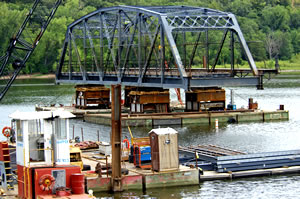 |
|
A pair of barges on the St. Croix River in the east Twin Cities metro area holds a section of the Stillwater Lift Bridge.The span was removed Aug. 9 as part of a year-long rehabilitation of the 74-year-old bridge. Photo by David Gonzalez |
The first major dismantling of the 74-year-old Stillwater Lift Bridge took place Aug. 9 when a crane lifted the last channel iron holding the #6 bridge span in place. Two small tugs on the south side of the barges holding the bridge span immediately began backing downstream and, in less than five minutes, the bridge section was completely out of alignment with the remaining bridge structure.
The navigational lights will be moved to the open span until the latter part of October when the section of bridge removed yesterday will be returned. In the meantime, bridge span #6 will be placed on a barge docked on the east side of the St. Croix River. It remains near to the existing bridge so deck work can continue on that segment.
Tuesday’s activity was just one of several changes the Stillwater Lift Bridge has undergone since the Metro District began the bridge rehabilitation project this spring.
In addition to replacing the bridge deck with reinforced cast-in-place concrete, the Stillwater Lift Bridge repair project includes:
-
Replacing the electrical components of the lift-span drive system, which were installed in 1983
-
Repairing the Tender’s House and constructing a supplemental Tender’s House on the north side of the lift-span immediately east of the existing Tender’s House
-
Replacing the pedestrian railings, including concrete repairs to the sidewalk support system.
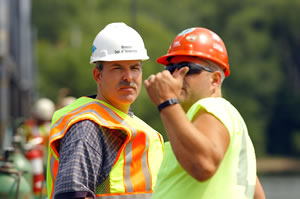 |
At left, Mark Spafford, engineering specialist, Bridge Office, confers with Mark Taylor, transportation specialist, Oakdale, during preparations to remove a section from the Stillwater Lift Bridge. Photo by David Gonzalez |
Although most of the work being done on the bridge is on the deck or below it, some changes are more visible, such as a interpretive sign explaining the historical significance of the bridge, which will be placed on the west side of the bridge.
The Stillwater Lift Bridge is expected to open to motorists by Nov. 1. Additional work on the bridge and adjacent areas after that time will not affect motorists. The entire project will be completed by May 2006.
By Mary McFarland-Brooks
|
back

|
 |
Congress passes reauthorization bill for federal transportation funding |
 |
 |
On July 29, Congress passed a $286.4 billion six-year reauthorization bill covering federal fiscal years 2004-09. The bill is called SAFETEA-LU, which stands for “Safe, Accountable, Flexible, Efficient Transportation Equity Act: A Legacy for Users.”
Approximately 79 percent of the SAFETEA-LU funding is for highway programs, 18.5 percent for transit programs, and 2.5 percent for other programs such as motor carrier safety, national highway traffic safety and research.
Lt. Gov./Commissioner Carol Molnau had been urging Congress to act quickly on the bill, noting that the lack of a reauthorization bill and the piecemeal fashion in which funding has been distributed to states under the short-term extensions have led to numerous problems and project delays across the country.
“After nearly two years of extensions, Mn/DOT is very pleased that Congress has finally passed a long-term transportation funding reauthorization bill. The new bill is good news for the country and will be of great benefit to Minnesota,” she said.
Although the details of the reauthorization package are still being reviewed, Minnesota state and local governments can expect to receive about $3.5 billion in federal transportation funding through 2009.
Congress also earmarked funding for over 6,300 projects totaling more than $24 billion in SAFETEA-LU. More than 145 projects were earmarked for Minnesota totaling more than $460 million. For a copy of the latest draft list of projects, contact Brad Larsen, federal relations manager, brad.larsen@dot.state.mn.us or 651/282-2170.
According to Larsen, this funding package is the second-highest highway increase in the country. However, much of this increase comes in the latter years of the bill, he said.
“This increase is partially in the formula programs – like Interstate Maintenance, National Highway System, Bridge, Congestion Mitigation and Surface Transportation Programs – and partially in the record-level of congressionally earmarked projects,” Larsen said.
He explained that the funding increases have long been anticipated, and Mn/DOT's current and long-range highway construction programs already reflect these higher funding levels.
“Many highway projects under construction throughout the state, and many planned for construction in the near future, are the beneficiaries of the new federal bill,” he said.
President Bush signed the SAFETEA-LU bill Aug. 10.
By Jeanne Aamodt
|
back

|
 |
Seeds Day celebration honors program graduates, supporters |
 |
 |
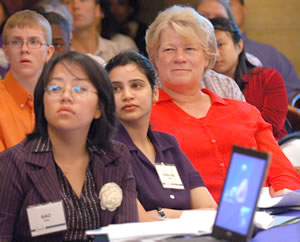 |
|
Seeds students Bao Thao, State Aid, and Ranjani Dasiga, Transportation Data and Analysis, watch a video abut the Seeds program with Lt. Gov. Carol Molnau. Photo by David Gonzalez |
When Ranjani Dasiga told her family in her native India that she had a permanent job in transportation they asked, “Will you be working inside the bus or outside the bus?”
Her family, Dasiga said, associates civil engineering with building dams and power plants—not roads and bridges and certainly not buses.
Dasiga related her story during the Seeds Day program that recognizes recent Seeds Program graduates, their mentors, supervisors and others who support the program.
She is among 10 of 12 Seeds 2005 graduates who earned permanent jobs with Mn/DOT and were honored Aug. 4 after earning their degrees while working with the department during their college years.
Dasiga, now working on a master’s degree in transportation engineering at the University of Minnesota, works as a planner in the Office of Transportation Data and Analysis.
The e-mail message from Seeds student Hosanna Teklyes about his appointment to the graduate engineer program went to his mother and siblings in his native Ethiopia as well as a sister living in Uganda and a brother who resides in Sweden.
Teklyes emigrated from Addis Ababa in 2002 to expand his education and career options. He’ll graduate from the University of Minnesota in December with a civil engineering degree, then join the grad rotation program.
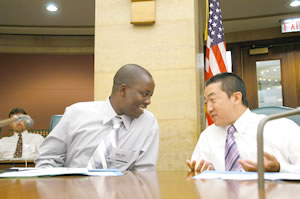 |
Malaki Ruranika (at left) and Mooa Sheen, both Seeds students in Land Management, chat during the Seeds Day celebration at the Capitol. Photo by David Gonzalez |
He currently works at the Maplewood Lab on the Minnesota Road Research Program.
“I’m gaining a lot of experience in engineering, more confidence and learning a great deal about research applications,” Teklyes said.
The arc of Dasiga’s and Teklyes’s lives and work experience match the Seeds Program’s mission—to attract and retain people of color and/or those from low-income families to career employment with Mn/DOT.
Lt.Gov./Commissioner Carol Molnau and Kevin Gray, Finance & Administration Division director, presented awards to the graduates and recognized 19 new Seeds students and program supporters.
They also cited Norm Plasch and Rob Lowe, Workforce Development, for their work to further develop young people’s interest in transportation careers.
Lowe initiated the Phoenix Program that links Mn/DOT with high school teachers and counselors to encourage junior and senior high students to pursue careers in transportation.
Plasch recently helped enroll 10 Seeds students in a highway design class usually reserved for more experienced employees to increase their knowledge of design concepts and their familiarity with construction processes.
Since its beginning in 1993, 356 students have enrolled in the program, said Emma Corrie, Seeds Program manager. More than half of those enrolled completed the program and graduated with degrees.
Of the 158 students who graduated, she said, 105 secured full-time positions with Mn/DOT and now serve as engineers, technicians, information technology specialists and supervisors throughout the department.
“More importantly, they are giving back to the program as advisory committee members, resource speakers, recruiters and as mentors for our newest students,” she said.
One Seeds graduate turned mentor is Steve McGregor, Network Services Unit supervisor with the Office of Information Technology. He joined Mn/DOT as a Seeds student at the University of Minnesota-Duluth in 1993.
Speaking at the celebration, McGregor congratulated the students on their accomplishments and encouraged them and other people to keep working to increase their knowledge, skills and earning potential.
“It pays to go to college,” he said.
By Craig Wilkins
|
back

|
 |
Hours of use for MnPASS I-394 Express Lanes now set |
 |
 |
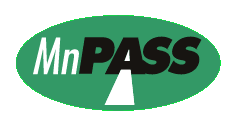 |
|
The MnPASS Interstate 394 Express Lanes west of Hwy 100 are now open for 20 hours each week day and 24 hours a day on the weekends. |
The MnPASS Interstate 394 Express Lanes west of Hwy 100 on Aug. 9 officially opened to general traffic up to 20 hours each week day, and 24 hours a day on the weekends.
When MnPASS originally opened on May 16, the express lanes were closed to general traffic 24 hours day. After receiving feedback from the public, Mn/DOT changed the hours to improve the efficiency of the lanes.
"We moved quickly in June to respond to the most significant concerns raised by users of the MnPASS system and the I-394 corridor," Lt. Gov./Commissioner Carol Molnau said. "This change in hours of operation should make I-394 operate more efficiently, while providing advantages to transit, carpools, motorcycles and MnPASS users during the peak rush hours."
The new hours are:
When the express lanes are open to general traffic, the MnPASS toll signs will read "OPEN." The reversible express lanes, located east of Hwy 100, will continue to be open only to transit, carpools, motorcycles and MnPASS subscribers.
Mn/DOT is also proceeding with construction of an auxiliary lane on the westbound side of I-394, Molnau said. The new lane will extend from Hwy 100 west to the Hwy 169 ramp and should aid in reducing congestion on that part of the roadway. Work on that lane should begin later this month and be completed by October.
Molnau cautioned drivers to be aware that there will be no changes to the entry/exit points throughout the corridor for the express lanes and that restrictions against crossing double white lines will be enforced 24 hours a day.
By Kevin Gutknecht
|
back

|
 |
Diversity forums for employees scheduled in September |
 |
 |
Employees are invited to attend the first in a series of diversity forums beginning in September.
The event will be offered in St. Cloud on Sept. 14 and in the Twin Cities metro area on Sept. 15. Lt. Gov./Commissioner Carol Molnau will kick off the Sept. 14 forum.
The forum will begin with a play adapted for Mn/DOT by the Pillsbury House Theatre, a multi-cultural theater company. The 40-minute presentation, Breaking Ice, consists of vignettes designed to spark conversation about workforce diversity, success, challenging times, and leadership. The play will be followed by a facilitated discussion with audience members.
“We really hope these forums will get employees talking about diversity issues,” said Lynnette Geschwind, affirmative action officer. “We need to be able to discuss diversity issues respectfully.”
This is the first of five diversity forums planned for 2005-06. The forums are open to all employees and will be held throughout the state. Future topics include listening through an accent, generations in the workplace, and gender- and race-related issues.
The forums are one element of renewed efforts to address diversity issues at Mn/DOT. In September the first group of managers will begin a nine-month Leadership Institute that will focus on diversity and leadership. Three groups of managers will participate in the Institute over the next two years.
The forums and Leadership Institute are recommendations based on a needs assessment conducted by the Affirmative Action Office, Diversity Council and Sentient Consultants during the last two years. The assessment reviewed data such as hiring practices, complaints and information from focus groups—all of which indicated that there was a continuing need to address diversity issues at Mn/DOT.
“This is training not generally available as a package anywhere else,” Geschwind said. “In the rapidly changing environment we have to work in, managers deserve to have this support. We believe the Institute will give managers the tools they need to recognize and address diversity issues.”
By Kay Korsgaard
|
back

|
 |
Transit tango: Top drivers take their buses through roadeo’s tangle of challenges |
 |
 |
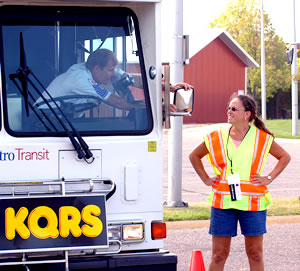 |
|
Barb Kryser, Office of Transit, helps manage the flow of competitors on the roadeo course. Photo by David Gonzalez |
Drivers from 14 transit systems faced off with their peers July 30 on a scorching Saturday morning to compete in the annual statewide bus roadeo.
The Mn/DOT-sponsored event was held at Century College in White Bear Lake.
When the twisting and turning between narrow rows of orange cones and other tests of driving skills ended, operators from Twin Cities Metro Transit and Tri-Valley Heartland Express emerged as the top scorers in the roadeo’s large- and small-bus categories.
The roadeo course simulates the challenges drivers face in their work.
Jack Berner, Metro Transit, took top honors in the large bus division. Ken Rakke, St. Cloud Metro Bus, placed second in the division.
Alan Altapeter, Tri-Valley Heartland Express, placed first in the small bus division. Roger Benitt, his co-worker, placed second.
Based in Crookston, the Tri-Valley system serves Marshall, Norman, Pennington, Polk and Red Lake counties.
Kent Ehrenstrom, transit planner with Bemidji/District 2, said the Tri-Valley system’s drivers did well because of their skills, experience as roadeo competitors and Tri-Valley’s commitment to training.
Barb Quade, a transportation planner with the Office of Transit, said the roadeo’s goals include promoting safe driving and pride among the state’s transit operators.
“The rodeo enables drivers to test their skills and underscores the critical roles that transit systems play in the lives of state residents,” she said.
By Craig Wilkins
|
back

|
 |
Wait, Tretbar receive awards for use of integrated pest management |
 |
 |
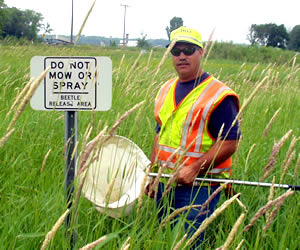 |
|
Scott Tretbar, St. Cloud Maintenance Area, recently was recognized for his use of integrated pest management to control and manage weeds along rights of ways. |
Two Mn/DOT employees recently were recognized by the state Integrated Pest Management working group.
Shannon Wait, transportation generalist at the Alexandria Truck Station, and Scott Tretbar, who works at the Maintenance Area in St. Cloud, received awards for their work in using integrated pest management to control and manage weeds along rights of ways.
The Minnesota Department of Agriculture nominated Wait for her work in Mn/DOT’s District 4 area. Among other activities, Wait is responsible for getting biocontrol to weed locations in Mn/DOT's District 4, writing grants for acquisition of GPS equipment from Mn/DOT maintenance research, providing training on GPS units to maintenance and construction personnel and designing sprayer and mower GPS data collection.
Susan Shaw, from the Mille Lacs County Agriculture Department, nominated Tretbar, noting his good work.
“He has done some real proactive control this spring,” Shaw said. “He suggested that the "OK" should not be given to harvest hay off sections of Hwy 169 where Wild Parsnip, a type of noxious weed, is growing.”
The IPM award is given annually.
By Lisa Yang
|
back

|
 |
Safety, traveler information will be focus of Mn/DOT’s State Fair booth |
 |
 |
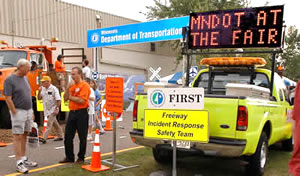 |
|
In 2004, Mn/DOT's exhibit at the Minnesota State Fair attracted more than 150,000 visitors. Photo by David Gonzalez |
Visitors to this year’s Minnesota State Fair can sit inside a Mn/DOT snowplow truck to learn how operators combine technology, an array of snow-fighting techniques and their expertise to keep highways safe and serviceable during the state’s long winters.
The exhibit’s theme, “Work Zones: Pay Attention or Pay the Price,” applies to winter snowplowing operations as well as summertime highway improvement projects.
“Our goal, as always, stresses the responsibility the public has to drive safely in work zones and our department’s charge to maintain the state’s transportation system as effectively and safely as possible,” said Bob Winter, District Operations Division director.
Booth visitors also have a chance to meet with Lt. Gov./Commissioner Carol Molnau who will make several appearances at the booth located on Judson Avenue at Underwood Street, just east of the Dairy Building.
Visitors also may learn how to use the state’s 511 Traveler Information System to get the latest updates on highway construction projects; see how Mn/DOT’s remote-controlled auto-flagger traffic directs traffic in work zones, and meet with staff from the Freeway Incident Response Safety Team, who help stranded motorists whose vehicles are stalled or damaged.
In addition, Mn/DOT’s Office of Aeronautics will be displaying unique aircraft at a separate exhibit located just north of the Como Ave. entrance next to the greenhouses. This exhibit will feature a portable air traffic control tower, an aviation weather information system, ultralight aircraft and a partly restored BT-15 “Valiant,” a World War II-era basic flight trainer. Representatives from the aviation industry and Mn/DOT will staff the booth.
The fair runs from Aug. 25 through Labor Day, Sept. 5.
For information about the Mn/DOT fair booth, visit http://www.dot.state.mn.us/fair/.
Volunteers sought to staff Mn/DOT fair booth
Volunteers are needed to staff Mn/DOT’s booth at the State Fair, from Aug. 25 through Sept. 5, according to Donna Lindberg, Communications.
Current openings are for evenings (3-9 p.m.), weekends and Labor Day. Admittance ticket, T-shirt and information will be provided. You need your supervisor’s permission. If interested in volunteering and for more information, call Lindberg at 651/297-8138.
|
|
back

|
 |
August edition of Drive to Excellence newsletter now available online |
 |
 |
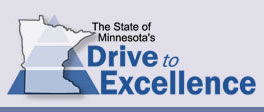 |
|
The August issue of The Excellence Report is now online and provides an update on the state's Drive to Excellence initiative. |
The governor has appointed the state’s first chief information officer to head the newly created Office of Enterprise Technology, according to the August edition of The Excellence Report, the state’s Drive to Excellence monthly newsletter.
Gopal Khanna’s appointment is effective Aug. 15. In his new role, Khanna, 55, will oversee a budget of $83 million and staff of 300. Previously, Khanna has served in several positions in the Bush administration, including as CIO and chief financial officer of the U.S. Peace Corps.
For more news about the Drive to Excellence initiative, see:
|
back

|
 |
|
 |



